Executions After Executions
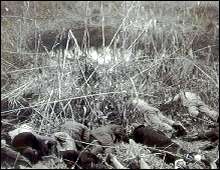
Persons executed by Japanese soldiers in Ku Ling Temple. Photo taken by an American missionary, Ernest Forster.
Due to the Imperial Army’s media censorship, though there were over 100 Japanese journalists in Nanking when the city was captured, those journalists did not dare to write anything “unfavorable” about their countrymen. [41]
Knowing that any atrocity story wouldn’t make news in Japan, the journalists instead described how “valorous” the Imperial troops were in combat inside and outside the walled city.
Accordingly the newspaper articles during and after the siege of Nanking were full of tales of the Japanese soldier’s heroic exploits. [42]
After the war, however, some of the journalists confided what they had witnessed. A special correspondent for Tokyo Asahi, Imai Masatake, for instance, reported only about the “majestic and soul-stirring” ceremony of the triumphal entry of General Matsui Iwane, the commander-in-chief of the Central China Area Army, and his troops into the city on December 17, 1937. But two days before the victory parade, he revealed in 1956, he witnessed a mass execution of 400 to 500 Chinese men near Tokyo Asahi’s Nanking office.
That evening Imai and his colleague also saw a “long, long” procession of hundreds or even thousands of Chinese people being led to the banks of the Yangtze near Xiaguan (Hsiakwan) riverfront. Convinced that all of them were going to be killed, they tried to follow the procession but were stopped by a sentry. Imai recalled a conversation he had with his partner while hearing the sound of bullets ricocheting nearby. A part of the article he wrote for a magazine years later read:
“While we saw what they were doing near the bureau, there was a car passing through,” said Nakamura.
“Yeah, I saw some foreigners on it.”
“I guess they were from China’s Red Swastika Society. This news will leak out to Geneva for sure.”
“I wish I could write about it.”
“Someday we will, but not for the time being. But we sure saw it.”
“Let’s go take a look again, with our own eyes.”
With that, two of us got up. The sound of gunfire had ceased by then. [43]
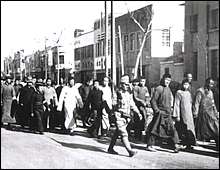
Chinese prisoners of war being led by Japanese troops.
Although the reporter apparently mistook the Red Swastika Society for an organization somehow related to the Red Cross, they guessed right about the news circulating around the world.
Another Tokyo Asahi reporter, Adachi Kazuo, also saw a mass murder near the paper’s branch office with his colleague, Moriyama Yoshio. “The ‘plain-clothes soldiers’ were shot to death one after another, right in front of their wives and children, who were weeping and screaming,” wrote Adachi in 1975 in a memorial on Moriyama’s death.
“Our hearts were trembling with anger and grief while people in Japan were probably rejoicing over the collapse of Nanking.” Adachi also quoted Moriyama as saying at the scene, “With this, Japan has lost the right to win the war.” [44]
A correspondent for Tokyo Nichi Nichi, Suzuki Jiro, encountered a few execution scenes and later wrote:
“When I went back to the Zhongshan Gate, I saw, for the first time, an unearthly, brutal massacre. On top of the wall, about 25 meters [85 feet] high, the prisoners of war were rounded up in a line. They were being stabbed by bayonets and shoved away off the wall. A number of Japanese soldiers polished their bayonets, shouted to themselves once [to raise their morale], and thrust their bayonets in the chest or back of the POWs.
I saw about ten stragglers bound by wire to a big tree…. One of them [Japanese soldiers] stood up in front of them [Chinese captives], shouted, “You killed our buddies!” and raised the pickax, then swung it down to the head of a powerless prisoner of war.” [45]
Matsumoto Shigeharu, the Shanghai bureau chief of Domei News Agency, interviewed his ex-colleagues, Arai Masayoshi, Maeda Yuji and Fukazawa Kanzo, who spent a few days as correspondents in Nanking after the capture of the city. According to his book, all of the interviewees told Matsumoto that they saw a number of charred bodies around Xiaguan area, probably between 2,000 and 3,000 dead bodies, on the 16th and 17th.
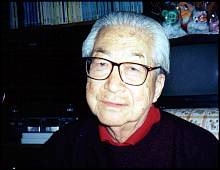
“I believe only what I saw,” says a former Tokyo Nichi Nichi photographer, Sato Shinju.
Maeda personally saw new recruits executing Chinese POWs with bayonets. After having seen 12 or 13 of them being “stabbed to death,” he retched and left the place. Maeda also heard that the Japanese troops were carrying out extensive mopping-up operations on the 14th and 15th. But he also remembered that the streets were becoming normal around the 20th.
Matsumoto noted that his interviewees all pointed out the difficulty at the time of distinguishing “massacre” and “extension of combat.” His interviewees dismissed the so-called “Great Massacre” of hundreds of thousands of people. Instead, the three journalists gave him an estimate of the civilian death toll at ten or twenty thousand. [46]
A Domei newsreel cameraman, Asai Tatsuzo, stated a similar notion when interviewed for a magazine article, “I thought executing plain-clothes soldiers and stragglers was what the war was all about.” [47]
Sato Shinju, a photographer for Tokyo Nichi Nichi newspaper, saw a mass execution of about 200 Chinese soldiers but also dismisses the “massacre of 200,000 or 300,000 civilians.” “I believe only what I saw,” says Sato in an interview for this documentary. “Surely I witnessed a mass murder once, but I also saw some makeshift food stands and street vendors in the Safety Zone. There might have been some atrocities, but I can’t believe such a high death toll.” [48]
Living Soldiers: What A Japanese Novelist Observed
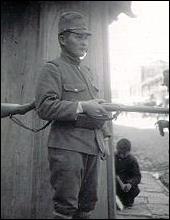
A Japanese soldier on sentry duty. March 1938.
Probably the most contemporary account of Imperial troops’ atrocities given by a Japanese national at the time was a fictional novel titled Ikiteiru Heitai or Living Soldiers, written in February 1938.
The author, Ishikawa Tatsuzo, later said that he was frustrated by the “conventionally identical news articles” from the China theater and had been wanting to see the war with his own eyes when afforded an opportunity to become a special correspondent for a magazine, Chuo Koron, in December 1937. Ishikawa left Tokyo on the Christmas day and arrived in Nanking on January 5, 1938, three weeks after the city was taken over by the Japanese troops.
During his eight days of field research in Nanking, Ishikawa got acquainted with the soldiers from the 33rd Infantry Regiment of the 16th Division. Soon Ishikawa came up with a story featuring a fictional platoon whose march toward Nanking was clearly based on the unit.
Unlike many heroic characters appearing in general wartime stories and news articles in Japan, in Ishikawa’s Ikiteiru Heitai [Living Soldiers] the main characters such as Privates Hirao and Kondo, Sergeant Kasahara, and Second Lieutenant Kurata, were absorbed in the reality of war. They engaged in whimsical killings, looting, rape, and arson throughout their march. [49] The following passage is one of those fickle acts his characters often commit in the story:
Hirao grabbed her by the collar and pulled her up, but she didn’t let go of the dead body of her mother until one of the soldiers twisted her arm and pulled the body away. The soldiers hauled the girl outside, her legs dragging on the ground.
Hirao screamed like a madman, raised his bayonet and stabbed the girl in the chest three times. The other soldiers also took their daggers and began stabbing her head, abdomen, and other parts indiscriminately.
She was dead within ten seconds. When she collapsed like a futon [pile of bedclothes] onto the dark ground, the warm smell of fresh blood wafted up to the flushed faces of the excited soldiers.
In the trench Second Lieutenant Kurata was aware of what was going on but did not say a word. When the excited soldiers came back to the trench spitting, Sergeant Kasahara was sitting cross-legged on the bottom of the trench smoking. He muttered with a detectable smile on his lips, “What a waste, indeed!” [50]
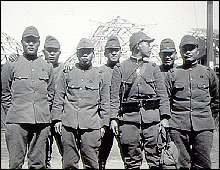
Japanese soldiers who quartered in the Pacific Ocean restaurant in Nanking. March 17, 1938.
The story was published in Chuo Koron March issue on February 17, 1938. And the very next day, the Ministry of Interior prohibited the sale of the magazine on the grounds that Ishikawa’s story “deliberately slandered the Imperial Army troops in the holy war” and was thus “improper in view of the state of affairs.” In August Ishikawa and his editor were indicted.
“People regard the soldiers at the front as someone like god and think there will be a heaven after they occupy the land,” testified Ishikawa in court. “People think Chinese civilians are cooperating with us to create the land of Perfect Bliss, but war is nothing like that at all. I believed it was of absolute necessity to let people know what war truly means, realize the situation is an emergency and prepare for what we are dealing with.”
In April 1939 Ishikawa was sentenced to four months in confinement suspended for three years. After being obscure for years, Ikiteiru Heitai [Living Soldiers] finally saw the light of day again a few months after Japan lost the Pacific War in 1945. [51]
Go back to: Table of Contents
[References]
- Shinichi Kusamori, “Fukyoka Shashin Ron: Houkoku no Shashin 2 [An Essay on Disapproved Photographs: Journalistic Photos on Japan 2],” in Mainichi Shinbun Hizou Fukyoka Shashin 2 [Stashed Photographs in Mainichi Newspaper: the Disapproved 2], (Tokyo: Mainichi Shinbun, 1999), 177-178.
- Hata, Nanking Jiken [The Nanjing Incident], 15-18.
- Masatake Imai, “Nanking Shinai no Tairyo Satsujin [Mass Murders in the City of Nanjing],” in Mokugekisha ga Kataru Showashi 5: Nichi Chu Senso [Showa History Told by Witnesses 5: Sino-Japanese War], 48-58.
- Quoted in Honda, 239.
- Quoted in Yutaka Yoshida, Tenno no Guntai to Nanking Jiken [The Emperor’s Military and the Nanjing Incident], 117.
- Matsumoto, 251-252.
- Masaaki Tanaka, Nanking Jiken no Sokatsu: Gyakusatsu Hitei 15 no Ronkyo [The Nanjing Incident Overview: Fifteen Reasons To Deny the Massacre] (Tokyo: Kenkosha, 1987), 232.
- Shinju Sato, interview by author, Fujisawa (Kanagawa Prefecture), Japan, 28 February 2000.
- Kazutoshi Hando, “Ikiteiru Heitai no Jidai [The Age of ‘Living Soldiers’],” in Tatsuzo Ishikawa, Ikiteiru Heitai [Living Soldiers] (Reprint, Tokyo: Chuko Bunko, 1999), 204; Hata, Nanking Jiken [The Nanjing Incident], 19-21.
- Ishikawa, 85-86.
- Hando, 201-208.
©2000 Masato Kajimoto. All Rights Reserved.
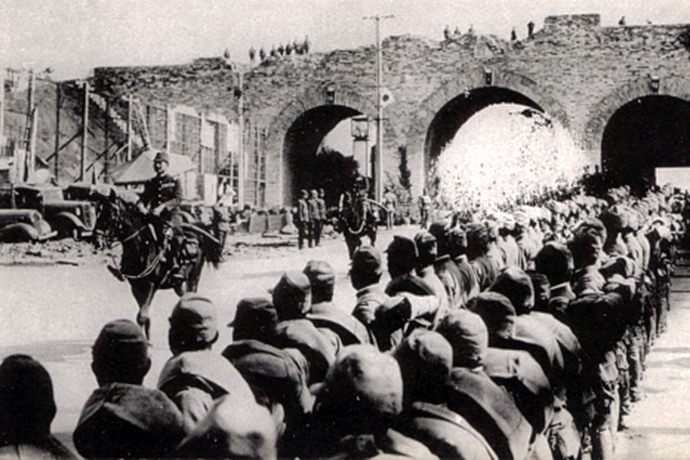





!["If you read his [Mr. Kurosu's] diary, you know it is something that you can't easily talk about," says Ono. Interview by author on March 11, 2000.](https://thenanjingmassacre.files.wordpress.com/2015/07/ono_kenji.jpg?w=640)




